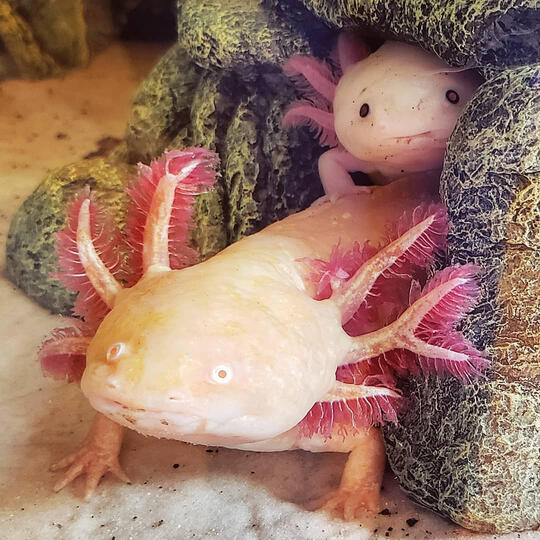
Axolotls
care & keeping
General
basics
Size: 8-14 inches fully grown
Axolotls over 18 months that are smaller than 6in are usually considered "minis"
Lifespan: 10-15 years on average, sometimes reaching 20 years.
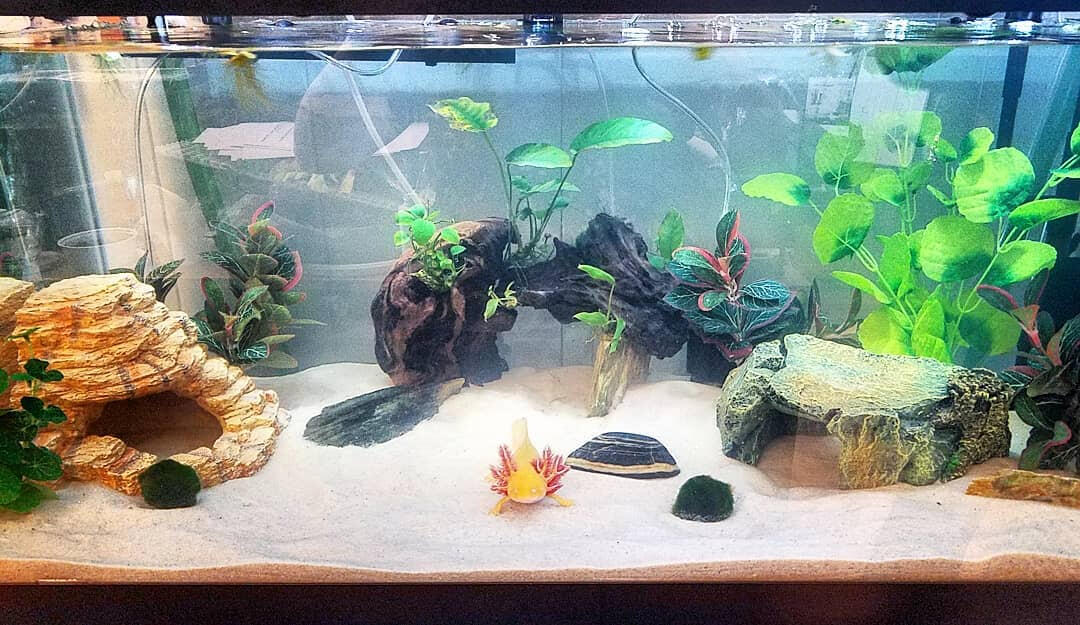
40g tank, juvenile axolotl (6 months)
Sex: Males will show a long, often large bump behind their legs. Females have a smaller, pointier bump. (See image for visual explanation). When young, it is difficult to tell the difference between male and female axolotls. Males will "drop balls" anywhere between 6 and 18 months of age.
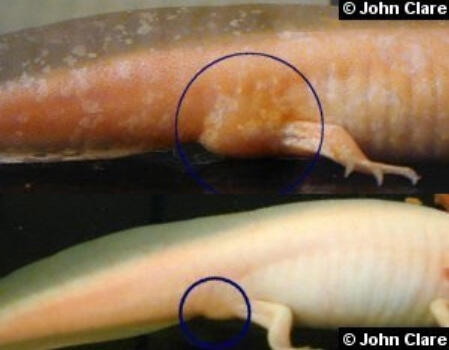
Male (top) & Female (bottom)
Tank Mates
Axolotls are a species only tank. They should NOT be kept with other fish or amphibians.
Housing SAME SEX axolotls together is fine. Be sure they are within about 2in in size of one another (and have a similar sized head) to avoid any accidental injury.
It is generally advised to avoid housing males and females in the same tank by using a divider. Males lay spermatophores (also known as sperm cones) which can easily float through small holes/gaps and still cause impregnation of the female. Spermatophores have even been known to travel through filters if the gaps are large enough.
Tank Mates
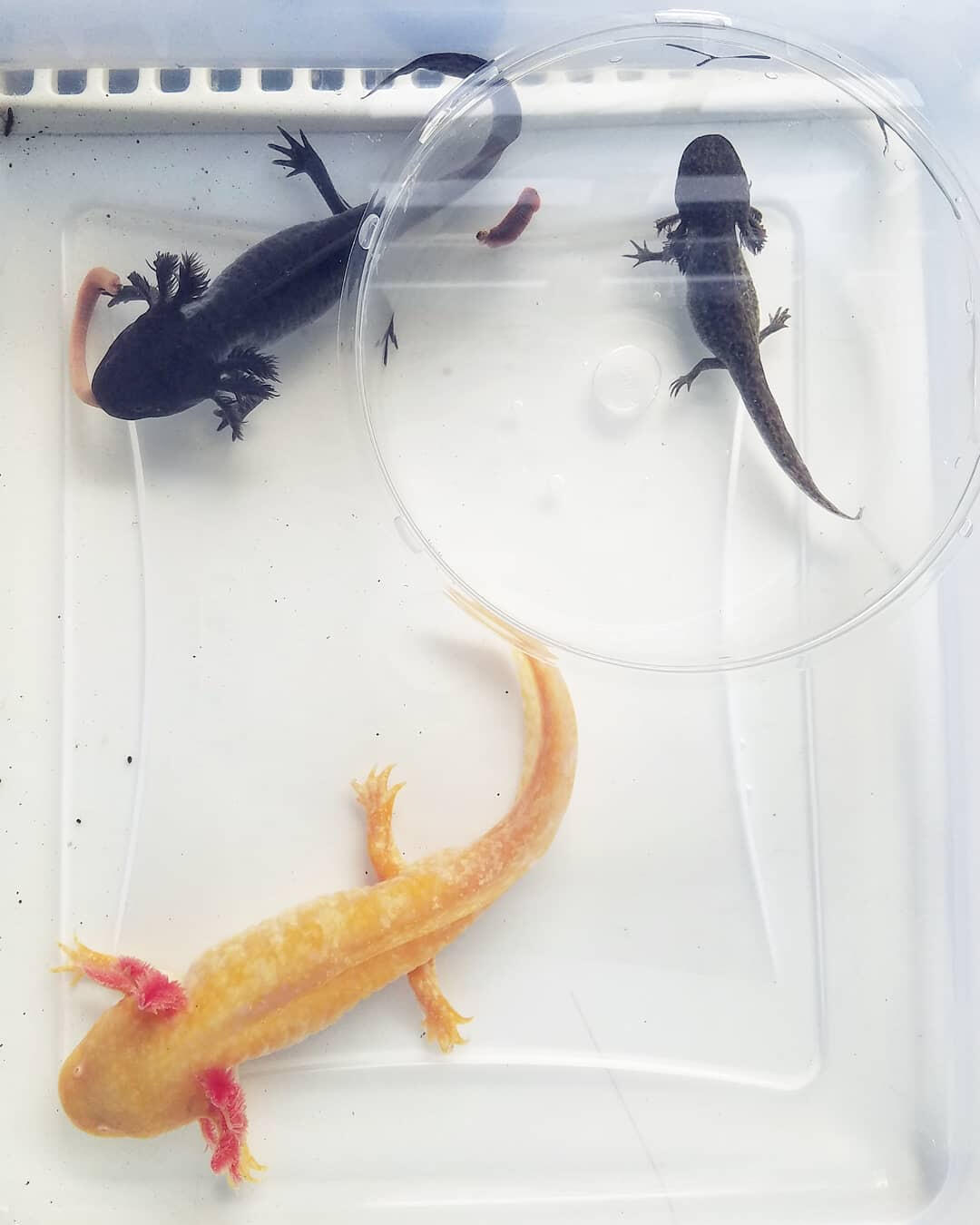
The image here shows three axolotls, almost or just over a year old with drastically different sizes. The smallest (top right) is 10 months and only 5 inches (a slow grower). The medium axolotl (top left) is 12 months and 8.5 inches. The largest (bottom) is 11.5 inches. While I would consider putting the largest and medium axolotls in the same tank, I would keep the smallest one separated until it reached the same size as the others. You can see how easily either of the other two could easily fit the smallest axolotl in their mouths.
Remember that axolotls are opportunistic feeders and if you're seeing biting or "aggression" it's possibly that the axolotls just need fed more .
Breeding
Breeding should only be done with extreme care towards genetics and health. If you do not know the genetic and health history of your axolotl, please do not breed them. Please seek out an ethical and responsible breeder if you are interested in getting into this aspect of the hobby.
Accidental Breeding:
Accidents happen. If you didn't realize you had a male and female together (which isn't hard to do), please separate the axolotls as soon as possible into different tanks/containers. If the female is under 18 months, keep an eye on her health as laying eggs is difficult. She may need extra food over the next week or so. As to the eggs, if the axolotls are related or you are unsure of their genetics, the best thing to do is freeze the eggs in a plastic baggie for a few days and then dispose of them.
Raising eggs is expensive, time consuming, and difficult. If your eggs are from a non-related, genetically sound pairing, be sure to consider the cost of food, time spent doing water changes, cost of housing, space taken up by housing, time spent feeding, etc. Additionally, because young axolotls do not sell for high amounts, you are unlikely to recoup costs when selling. Shipping is also expensive if you go that route as are the costs of tables at exotic pet shows. Many first time clutches also fail and die-off. If you are interested in raising babies from eggs, contact a breeder to see if they would be willing to send you eggs instead.
tubbing
Tubbing is a commonly used term that means you're putting your axolotl into a tub instead of a tank. There are a few reasons this can be helpful including:
deep cleaning the tanktank needs to cycle (either new tank or cycle crashed)treatment for a sick or injured axolotl
I personally keep multiple size tubs for various needs. Small tubs for transport, emergencies, and medical treatments and larger tubs for deep cleaning the tank (I usually put all three in one large tub after feeding). Below you can see how I modified the lid of my 15qt large tub so that I could still lock the lid and keep cats out but also run a fan across the top to keep the water cold!
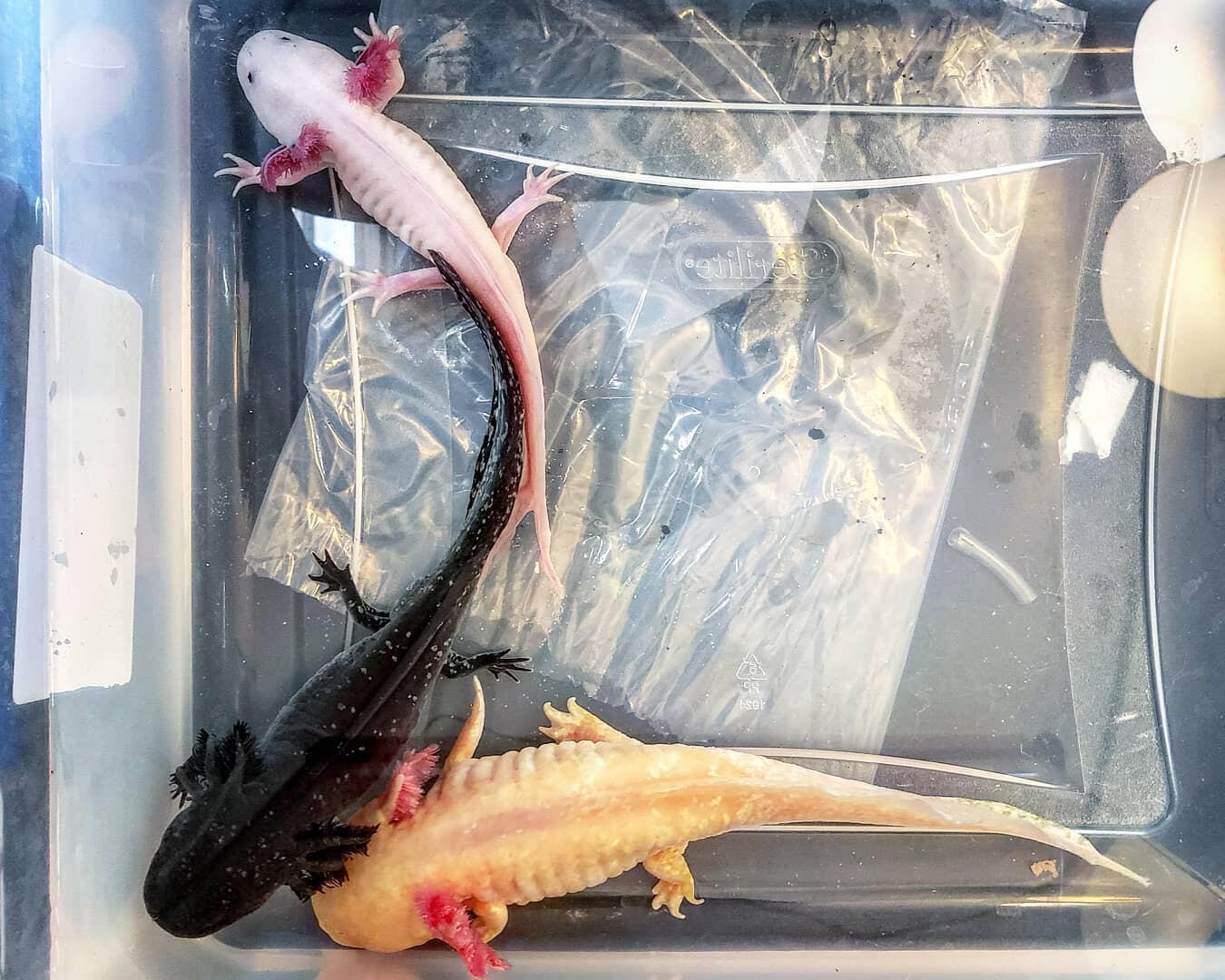
Tank setup
Cycling your aquarium
Probably the most important step to starting off well is to cycle your aquarium BEFORE getting your axolotl. Cycling your tank means that you are making sure the aquarium nitrogen cycle is established. The nitrogen cycle is what keeps your tank healthy, introducing beneficial bacteria to the filter media.
Cycling from new usually take a month or two. However, there are options to use filter media from an established freshwater aquarium to jumpstart your aquarium cycle. You can check local aquarium groups/clubs, ask a friend, check with your local fish store, or even purchase active filters online! Just be sure to watch out for any contamination that could harm your tank.
Here is a fantastic guide to cycling your aquarium: Cycling Aquariums the Easy Way
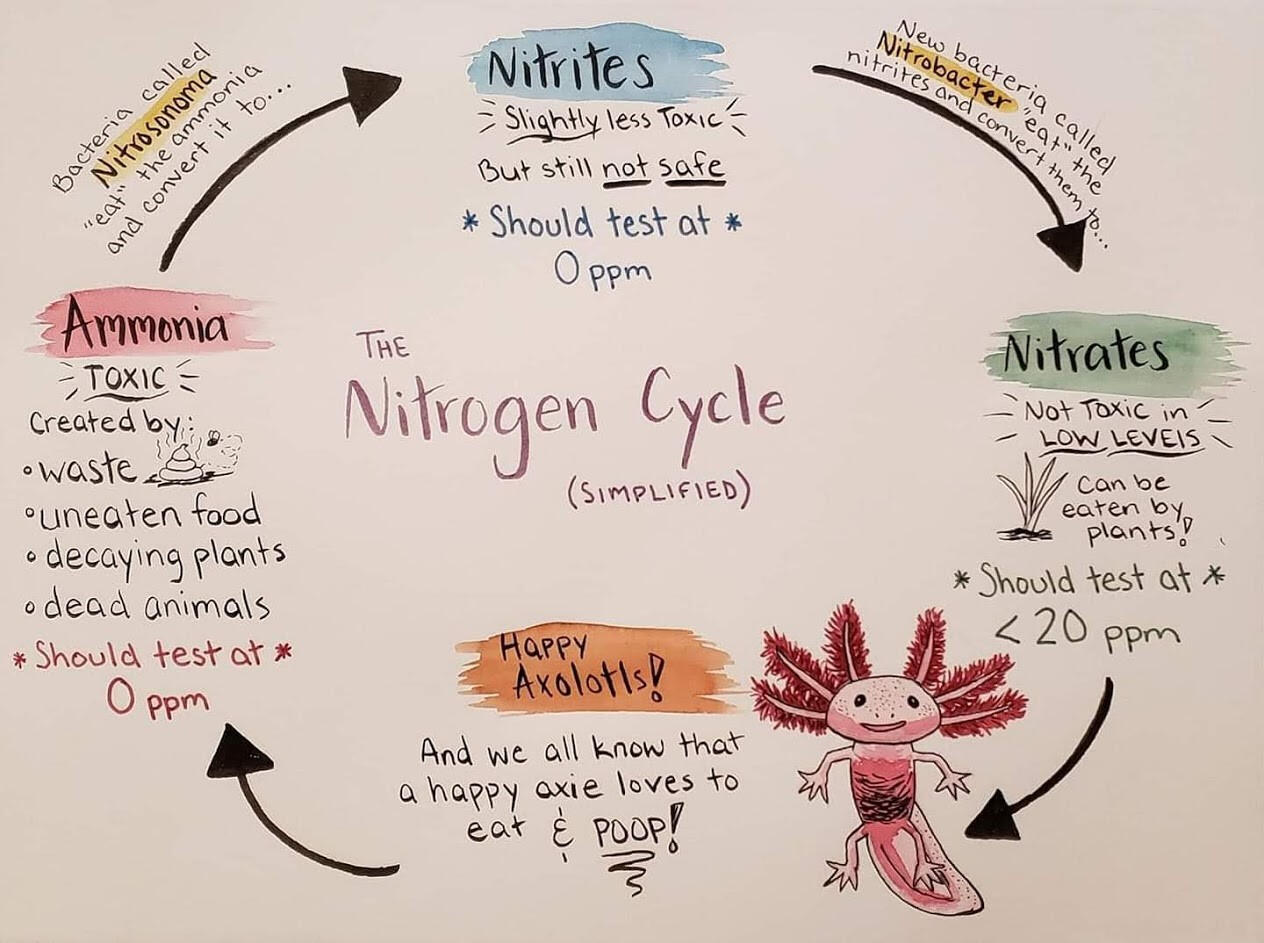
TESTING YOUR AQUARIUM:
One of the best and easiest ways to know if your aquarium is safe for your axolotls is to do a water test. I personally use the API Liquid Master Freshwater Test Kit. Avoid paper test strips since they're known to be inaccurate and can mislead. Any liquid test kit should work here. Follow the instructions closely on whatever test kit you use. Regardless of which kit you decide to use, your tank is safe when:
Ammonia = 0ppmNitrite = 0ppmNitrate = 20ppm or less.
Water changes should be done to keep your nitrates under 20 ppm (Nitrates up to 30-40ppm can be tolerated but should be avoided in the long term.) For most people, this usually means a 20-30% water change per week but depending on your tank size, number of axolotls, and amount of filtration, that can vary between 10%-80% per week or even every two weeks.
A note: Some people talk about not using test kits or never cycling their tanks. ALL tanks cycle eventually and using a test kit is a really easy way to be sure that you're not harming your axolotl. On most axolotl groups or forums, if you ask for help, one of the first questions will be "What are your parameters?" This is because it's far easier to rule out problems once they know what is happening in the tank. Most of the issues I have personally come across are almost always due to parameters being off in some way that is easily monitored with a test kit.
WATER QUALITY:
Depending on where you live and what water you use to fill your tank, you may need to add dechlorinators or other products to your water to keep your axolotls (and beneficial bacteria) safe from harm.
If you use treated water, make sure to get a treatment report from the water facility. If your water treatment plant uses chloramine you will need to add a dechlorinator. If they ONLY use chlorine you can leave the water sit out for 24 hours before use OR add a dechlorinator and use it immediately. Chloramine does NOT off-gas like chlorine does and must be treated with a dechlorinator to avoid causing harm to your tank.
Some places have very soft water (you can test this by using the pH, GH, and KH tests in the API test kit). Axolotls prefer hard water and if the water does not have enough minerals, you might need to buffer the water with calcium to raise the hardness to an appropriate level. However, it is better to have a steady pH so if your axolotls are not showing signs of long-term anemia and have no other problems, slightly softer water is acceptable.
Lastly, if you are having problems with your tank or axolotl's health, the best thing to do is switch to spring water until the issue is resolved. DO NOT USE DISTILLED WATER or RO (reverse osmosis) WATER unless you have added the appropriate minerals before using. I use Kent RO Right since I can get RO/DI water at my local fish store. Make sure you are mixing the proper amount of solution for volume to avoid swings in your parameters. Generally, just using spring water is the preferred method to avoid any mistakes.
Tank size
20 gal minimum water volume (around 200 square inches of floor space for one adult axolotl.
+10 gallons / 200 sq in for every added adult.
Axolotls need more floor space than height. Look for low and wide tanks instead of tall or narrow tanks. Tanks usually dubbed as frag or breeder tanks are ideal. Very common tanks in the hobby are the 40 gallon breeder or 50 gallon lowboy.
Temperature
60°F-65°F is ideal
58°F-68°F is the best range. Anything higher than 68°F can cause a greater risk of fungal growth, bacterial infection, and other illness.
Axolotls need cold water. A common method to cool water is by using evaporation. With a mesh or open-grid style lid you can run fans across the top of the water which allows the tank to cool down. Be sure to replace water as needed if using this method.
Although it is more expensive, the most reliable way to keep an aquarium cool is to use a chiller. Make sure you get one that is suited for your aquarium's size. Secondhand chillers are perfectly acceptable but be sure to thoroughly flush them out to avoid any contamination.
substrate
Bare bottom or sand. Slate, tile or false grass is also an option. Be sure anything added to the tank does not use adhesive. If using anything plastic, be sure that it is not going to leech toxins into the water.
Absolutely no gravel, rocks, beads, etc. Anything less than 2 times the size of the axolotl's head can be swallowed and cause injury or death.
Juveniles under 4 inches shouldn't be kept on sand due to impaction risk.
_
Filtration: Go with double the tank size at a minimum. They produce a lot of waste and need high filtration.
filtration
Axolotls produce a lot of waste and need high filtration. Utilizing multiple types of filtration can help keep the tank clean as well.
At a minimum, the filtration amount should be double the size of the tank. (A 20 gallon tank should use a filter rated for 40 gallons). More filtration is never a bad thing!
Types of filters to consider:
External CanisterSponge FilterHang on Back (HOB)Sump
Types of filter media to consider:
Ceramic RingsSponge (coarse, med, fine)Bio-balls
Many filters, especially HOBs, come with carbon packets that suggest you replace the filter once a month. This is slight misinformation - the carbon does need to be replaced every 30 days, but carbon isn't really necessary in the tank unless you're removing medication. If you want to use a HOB, you can replace that carbon filter with ceramic rings, sponges, or many other types of filter media. If you've already cycled your tank with the carbon filter, then make sure to keep the outer casing/bag and just dump the carbon so you don't crash your nitrogen cycle!
feeding
Staple Diet
Canadian nightcrawlers/dew wormsEuropean nightcrawlers/red wigglersAxolotl pellets (high quality sinking carnivore/salmon pellets)Repashy grub pieBlackworms (for babies or rescues, too expensive for sustaining an adult)
Never leave live fish in tank with axolotl to avoid gills being nipped/injured
All live feeders should be quarantined for at least 1 month (3 months recommended).
Ghost or Cherry Shrimp (can be left in tank)GuppiesMolliesPlatiesSwordtailsWhite Cloud minnow
Treats
No more than 1x a week, if that.
Blackworms (can be used as treats for adults)Wax wormsButter wormsBlack fly larvaeMaggotsFruit fly larvaeHorned worms (REMOVE HORN)
in a pinch
Frozen bloodwormsFrozen brine shrimp cubesRAW frozen, then defrosted salmon or shrimp (often good for sick axolotls that need to put on weight)
NEVER FEED
Anything with an exoskeletonWorms found by a road or a place where pesticides and/or herbicides may have been usedSuperwormsMealworms
CricketsFeeder minnows or goldfish - (both contain thiaminase which blocks the absorption of the essential vitamin thiamine.)Beef, Lamb, chicken, etcAnimal heart
about

TAMAGO
High white golden albino
Split gill (5 branches) on right side
Male
Date of Birth: December 16th, 2017
Adopted: June 30, 2018
Breeder: Karen Egan / Carolina Axolotls
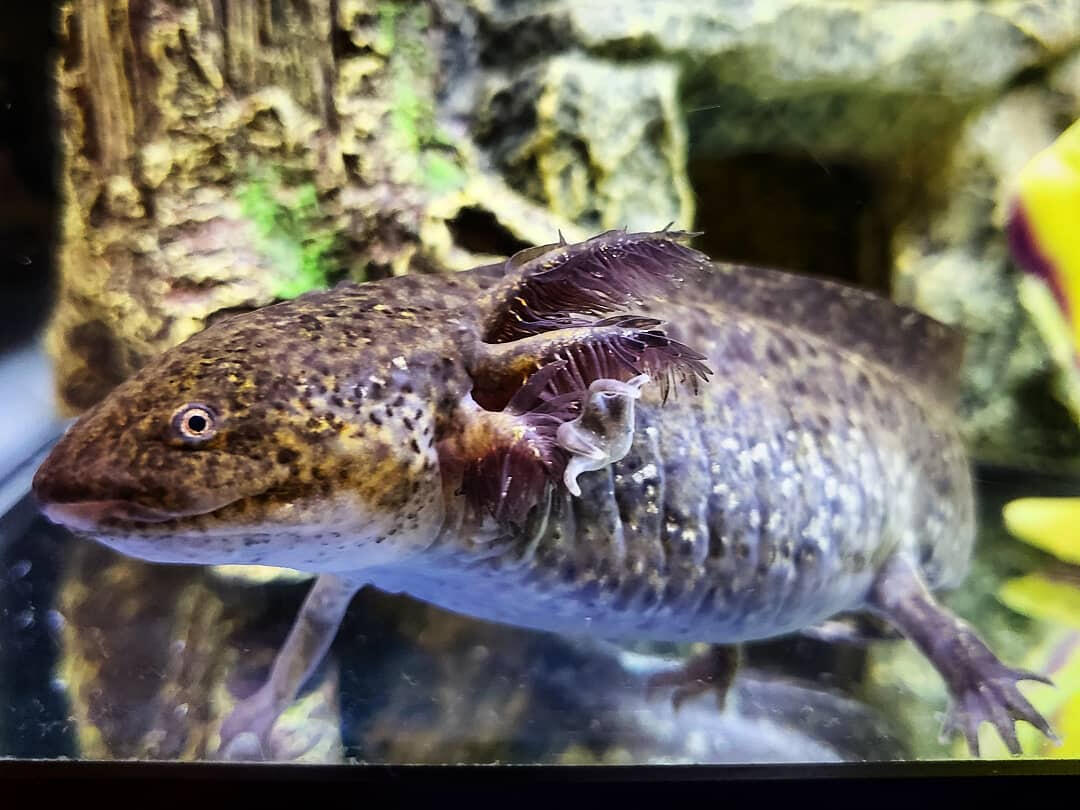
WAGASHI
High iridophore "starburst" wild
Male
Date of Birth: April 28th, 2018
Adopted: August 2nd, 2018
Breeder: Kayla Mull / Amphibian Empire

GYOZA
Leucistic axolotl
Split "mermaid" tail
Male
Date of Birth: March 10th, 2019
Adopted: January 10th, 2020
Breeder: Oliver Perry / Yin&Yang Axolotls

Aquarium Setup
40 gallon breeder tankAngels Plus large sponge filter running on an AquaCulture MK-1504 air pump (20-60g)SunSun HW-304B 5-stage external canister (525GPH, 9W UV sterilizer)JBJ Arctica Titanium Chiller 1/10HP (DBA-075)
TheTeaCritter / Sebastian
Tea chugging, book loving, axolotl enthuiast living in North Carolina and doing their best to help others learn more about these awesome little critters!
Seb also does other aquatic & wildlife rehab as well as care for the rest of their menagerie of pets including two goldfish, a betta, and four cats (only one of which is theirs).
recommendations
These are what I use or would recommend. Anything underlined is a direct link. Some amazon links are affiliated which helps me continue to run the site and provide support for hobbyists!
Please search around for better prices as costs may have changed since linking. Additionally, many of these products can be purchased second-hand on facebook marketplace, ebay, or other re-sale sites. Always reach out to local aquarium groups/clubs/societies as well as local pet stores!
If you would like to help out a little and support my work educating others about axolotls and continuing to rehab or rescue animals, my kofi is linked here and below! Ko-fi.com/theteacritter
API Liquid Master Freshwater Test Kit and for more detailed testing, consider adding the KH/GH tests as well.
JBJ Arctica Titatium Chiller (I use 1/10HP DBA-075 which can manage up to 130g. However, if you have a smaller tank, the Mini 1/15HP DBI-050 for 40g or less might be perfect (and cheaper!)
Egg-Crate Light Diffuser Panel is perfect for aquarium lids, dividers for different size axolotls (NOT FOR SEPARATING SEX), and cover tub lids to keep axolotls safe
Sterilite 15 Quart Latch Box awesome for tubbing axolotls - lid can be easily cut out and mesh or egg crate diffuser attached to keep axolotls safe from other pets or jumping accidents.
Seachem Prime is one of the best dechlorinators to use. Other dechlorinators can contain harmful ingredients. Avoid anything with aloe or that is designed to improve "slime coat" on fish.
External Canister Filter (I use a SunSun HW-304B)
Air Pump (AquaCulture has worked well for me, though I also have used Whisper.)
CaribSea Super Naturals Aquarium Sand (you can go with any of their ph-neutral sands, but I like this brand because the grains are very small & it means waste sits on top rather than getting trapped below the sand)
Anubias (great low-light/cold water plant - doesn't need to be buried in substrate)
Mopani Driftwood
Cattapa Leaf (aka: Indian Almond Leaf / IAL)